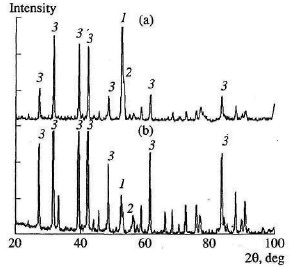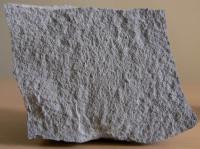(3519) 580-155, mail@ntpf-etalon.ru
|
|
Ferrosilicon Nitride SH-Synthesis. Part 2The article's begining - Ferrosilicon Nitride SH-Synthesis. Part 1 We know that a filtrational-combustion mechanism is responsible for the nitriding of metal powders, including silicon. In the filtrational version of self-propagating high-temperature synthesis, the gaseous reagent is supplied to the combustion zone by filtration through a porous medium formed by the metallic component. In nitriding ferrosilicon, filtration is maintained by the difference in nitrogen pressure between the reaction zone and the surroundings. The pressure in the combustion zone falls steadily as a result of nitrogen absorption by the alloy at high temperature. Nitrogen must be supplied to the combustion zone by filtration from outside because in ordinary conditions (at normal atmospheric pressure and room temperature), the quantity of nitrogen in the pores of the ferrosilicon powder is very small and clearly insufficient to maintain nitriding by self-sustaining combustion. Moreover, calculations show that the nitrogen in the pores is insufficient for nitriding of the ferrosilicon even at elevated pressure. For example, at 10 MPa, the nitrogen within the powder is only sufficient to bind 1-5 % Si in the nitride, depending on the ferrosilicon composition and the porosity of the powder batch. That degree of nitriding may increase the temperature in the Fe-Si-N2 system by no more than 200-500 °C, which not only is insufficient for a self-propagating process but also eliminates the possibility of reaction. For filtrational combustion, the process parameters depend strongly on the characteristics of the reacting system that determine the filtration conditions: specifically, the nitrogen pressure, the dispersity of the ferrosilicon powder, and the porosity and geometric dimensions of the batch. In addition, the parameters of ferrosilicon combustion in nitrogen depend on the initial conditions determining the thermal balance in the system: in particular, the quantity of inert components, the initial temperature of the ingredients, the introduction of activating additives, and the possibility of melting of the initial powders and/or reaction products. The influence of the silicon concentration in the initial ferrosilicon and the nitrogen pressure on the combustion rate, the degree of nitriding of the alloy, and the maximum temperature in the reaction wave is illustrated in Fig. 1. The results are obtained for self-propagating high-temperature synthesis in 15-1 experimental apparatus. A quartz-glass window permits visual observation of the combustion process and video recording of the combustion-wave propagation. The laboratory apparatus also includes a system for continuous measurement of the combustion temperature by means of thermocouples and computer recording of the temperature profile. Nitriding is based on FS90, FS75, FS65, and FS45 ferrosilicon powder (State Standard GOST 1415-93), with 89.9, 79.4, 68.1, and 48.25 % Si, respeclively, and 0.06, 0.08, 0.07, and 0.23 % C, as well as standard quantities of other impurities. In all cases, the particle size of the powders is no more than 0.08 mm. Fig. 1. Influence of the silicon content in ferrosilicon on the combustion rate (a), nitriding degree (b), and combustion temperature (c) when PN2 = 3 (1) and 7 MPa (2).
According to the Fe-Si phase diagram, alloys with a high Si concentration consist of two phases: silicon and iron disilicide FeSi3. With increase in Si content in the alloy, the content of free silicon also increases, as confirmed by X-ray phase analysis of the initial ferrosili-con p owder. Thus, whereas FS65 alloy contains no more than 25 % free silicon, FS90 alloy contains 80-85 % free silicon. Low-silicon FS45 also has a two-phase structure: about 70 % FeSi2, and the remainder FeSi. As expected, increase in the initial content of silicon is accompanied by more vigorous reaction of the silicon with nitrogen; this corresponds to considerable increase in combustion rate and increase in nitrogen concentration in the products. At the same time, the degree of nitriding of silicon in the alloys declines with decrease in their iron content. Thus, despite the relatively low nitrogen content in FS45 ferrosilicon, the degree of silicon conversion to the nitride is a maximum: almost 90 %, as against 65 % for the alloy with 90 % Si. The dependence of the combustion rate, nitrogen content, degree of nitriding, and combustion temperature on the silicon content in the ferrosilicon does not depend on the nitrogen pressure. Increase in the pressure strongly affects the combustion rate, but hardly changes the degree of nitriding of the alloys. With increase in pressure, the combustion temperature rises somewhat. X-ray phase analysis of the combustion products of ferrosilicon in nitrogen shows that, over the whole range of initial parameters, the basic phase is β-silicon nitride. No pronounced quantities of α-silicon nitride are seen. This is probably because the α-structure is only stable up to ~1400 °C and is converted irreversibly to the β-structure at higher temperatures. The combustion temperature of ferrosilicon in nitrogen is more than 1750 °C for all the initial conditions considered, and therefore α-Si3N4 formation is unlikely. Typical X-ray patterns of the nitriding products of FS45 and FS75 are shown in Fig. 2.  Fig. 2. Typical X-ray patterns of the nitriding products of FS45 (a) and FS75 (b) ferrosilicon:
(1) Fe; (2) FeSi; (3) - βSi3N4 In studying the nitriding of ferrovanadium in conditions of self-regulating combustion, it was found that the absorption of nitrogen in stages is possible, depending on the aggregate state of the products behind the combustion wave. If the liquid content in the combustion product is high, a gas-impermeable structure is formed immediately behind the combustion wave. When refractory components form a large proportion of the reaction products, the material remains gas-permeable, and nitrogen absorption continues beyond the combustion wave in bulk-combustion conditions. Note that a second stage to complete the combustion will not occur unless a permeable structure is retained and conversion in the combustion wave is incomplete. The latter condition generally holds in practice, since the powder particles are too large to permit combustion in kinetic conditions, i.e., conditions eliminating diffusional and filtrational obstacles to chemical reaction. Analysis of the sample structure shows that, in all cases, considerable permeability of the ferrosilicon nitride persists. The porosity of the combustion products is 35-55 %, depending on the conditions of synthesis. With such high porosity behind the combustion front, intense absorption of nitrogen is possible. To determine the contribution of such nitriding to the total nitrogen content in the combustion products, combustion is interrupted by sharply reducing the pressure in the working volume of the reactor, and then introducing argon. Chemical analysis of the samples quenched in this way shows that the final combustion stage considerably increases the nitrogen content. The proportion of nitrogen absorbed after passage of the laminar-combustion wave as a result of the final combustion stage may amount to 30 %. The great contribution of the final nitriding stage to the total nitrogen content may be attributed, in particular, to the weak pressure dependence of its content in the product. The typical structure of ferrosilicon nitrided by combustion is shown in Fig. 3.  Fig. 3. Macrostructure of SHS-ferrosilicon nitride
Exceptionally uniform distribution of nitrogen over the volume of the product is important here. In fact, ferrosilicon nitride is a composite consisting primarily of silicon nitride. The binder is iron and its silicides. With a high nitrogen content in the product, the proportion of free iron rises; with decrease in the degree of nitriding, the quantity of silicides increases. Since the density of Si3N4 (3.19 g/cm3) is much less than that of iron and its silicides, the content of silicon nitride in the product is very high (80-95 vol %). A 0.15 m3 SHS reactor has been developed at NTPF Etalon Co., Ltd for the industrial production of SHS ferrosilicon nitride and other materials. It takes the form of a thin-walled metal vessel with systems for cooling, gas injection and extraction, ignition, and sealing. Thanks to a reactor design with an accelerated-cooling system, SHS technology went into operation on an industrial scale; the working temperature is up to 2200 °C, with one-lime loading of up to 0.3 t of batch. The new sealing systems permits safe and reliable synthesis in filtrational combustion ai a nitrogen pressure up to 15 MPa. The time required to open and seal the equipment is reduced to a minimum. The shop for the production of ferrosilicon nitride and other SHS materials includes sections for crushing and fine grinding, drying and charging of the crucibles, and synthesis, as well as dispatcher and central control panels, a certified laboratory for intake monitoring of the raw materials, and a store for the initial materials and the final products. In the synthesis section, there are 20 SHS reactors; the total area of the shop is 3000 m2. The new shop can produce up to 10 t of various materials per day. The universal design of the SHS reactors permits the production of a wide range of materials based on inorganic refractory compounds of nitrides, borides, carbides, sulfides, and soon. Synthesis in reactive gas (nitrogen), argon, or vacuum is possible. The table presents the compositions of the ferrosilicon nitride produced and supplied by NTPF Etalon Co., Ltd. The products FSN35 and FSN30 are intended for the refractory industry. JSC Spetsremstroi (Magnitogorsk) uses such ferrosilicon nitride to produce water-free tap-hole material of type SiO2 – Al2O3 - SiC - С. Mainly FSN20 and FSN15 are used for alloying; they ensure high and stable assimilation of nitrogen by the steel. Thus, SHS technology for the production of a new material, ferrosilicon nitride, has been developed and industrially introduced by NTPF Etalon Co., Ltd, and the first Russian system for the large-scale (in amounts of a few tons) production of metallurgical materials based on refractory inorganic compounds has been created. Published in "Steel In Translation" Volume 38, Number 1, January 2008 (article in pdf)
Ferrosilicon nitride NITRO-FESIL®, produced by NTPF Etalon ltd: Other publications about SHS |
